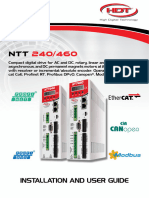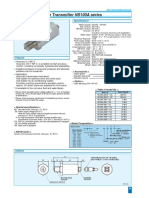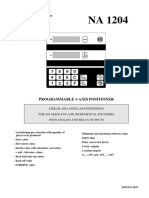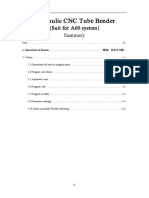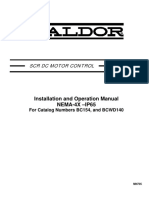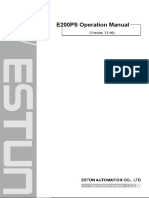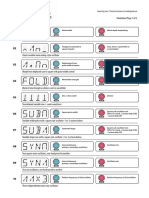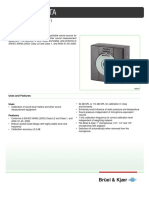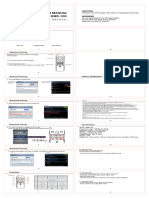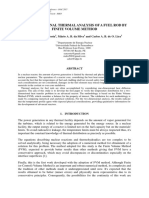S525 Shears - en
Uploaded by
noname1789S525 Shears - en
Uploaded by
noname1789Info documento:Commenti SHEARING MACHINE Instruction Manual
Introduction
The purpose of this manual is to provide the indications required for installing and
using metal plate shearing machines.
Consult the relative hardware manual for further details about the installation.
Operating logic
The operating logic of the machine is managed by using dedicated keys to select several
functional statuses (or functions), each of which may be displayed on one or or pages.
These pages are generally accessed by pressing the same key as the one used for
accessing the function, several times.
Press the relative function key to switch from one function to the other. This may not be
possible in certain cases, e.g. when a movement of at least one axis is activated.
However, this depends on the type of application.
Each functional status, or page, can be associated with its own “contextual menu”.
This menu contains a list of functions (up to 10), each associated with a numeric key
from [0] to [9]. If available, this menu is generally displayed when the [MENU] is first
pressed.
While there may or may not be a contextual menu, the “service menu” can always be
called up from each page. This menu is also the numeric selection type and is also
displayed by means of the [MENU] key. Press [MENU] consecutively, the first time to
display the contextual menu (if any), followed by the service menu, while a further
pressure on the [MENU] key will go back to displaying the selected page.
Axes managed
The following axes can be managed with this application:
“X” axis, or rear locator. It is generally read by the encoder and is managed like a
proportional axis.
“I” axis, or blade gap or interspace. It is generally read by the potentiometer and is
managed like a one-speed axis.
“A” axis, or angle. It is generally read by the potentiometer and is managed like a
one-speed axis.
Each axis can be included or excluded. Obviously, at least X axis must be present.
Both “A” axis and the blade up/down movement are controlled if “A” axis is included
and its position transducer is on the blade travel. Each time reference is made to the
blade up/down movement in this manual, it means the “BLADE” axis and must not be
confused with “A” axis.
The end of cutting or blade down target (“BDC”) and the blade up target (“TDC”) can
be calculated if the “BLADE” axis is controlled. However, the calculations are
conditioned by the settings of certain general parameters (consult the description of the
parameters for further details).
Esa/Gv Info documento:Parole chiave Numero pagina
SHEARING MACHINE Instruction Manual Info documento:Commenti
Calculation of the blade up target (TDC)
This target is calculated in the Manual, Semiautomatic and Automatic functions and
only in the presence of the following conditions:
ANGLE axis defined
(PG16) Blade-guide distance different from zero
(PG18) Horizontal blade height different from zero
TDC parameter in the HEADER step of the program different from zero
This parameter, which is in the HEADER step of the program, can be given a positive
or negative setting and depending on this, takes on a different meaning. If it is positive,
it shows by how much the blade, from the guide side, must lift in relation to the metal
plate thickness. If it is negative, the blade positions so that there is this programmed
space between its intersection with the base and the position of the transducer (blade up
side). This latter function is generally used for machining with different areas of the
blade, so as to resolve problems concerning blade wear.
Also remember that there are correction parameters for the calculated value (see
parameter PG02).
+
A
LAM
QUOTA ATTUALE LAMA
Fulcro
rotazione lama
C
PMS
GUIDA
PMS
impostato
(positivo)
PMS
SP (spessore)
0
Larghezza (L)
PMS impostato
(negativo)
BASAMENTO
PG17
PG16
Numero pagina Info documento:Parole chiave Esa/Gv
Info documento:Commenti SHEARING MACHINE Instruction Manual
Calculation of the blade down target (BDC)
Similarly to TDC, this target is calculated in the Manual, Semiautomatic and Automatic
functions and only in the presence of the following conditions:
ANGLE axis defined
(PG16) Blade-guide distance different from zero
(PG18) Horizontal blade height different from zero
BDC parameter in the HEADER step of the program enabled.
This parameter, which is in the HEADER of the program, allows the BDC calculation
to be enabled or disabled.
Also remember that there are correction parameters for the calculated value (see
parameter PG03).
A
LAM
QUOTA ATTUALE LAMA
Fulcro
rotazione lama
C
ALTEZZA LAMA
GUIDA
PMI
-
0
Larghezza (L)
A
BASAMENTO
PG17
PG16
Keys for directly accessing the functions
Allows the settings page to be accessed (program EDITOR)
Esa/Gv Info documento:Parole chiave Numero pagina
SHEARING MACHINE Instruction Manual Info documento:Commenti
Allows the manual function to be accessed.
Allows the semiautomatic function to be accessed.
Allows the automatic function to be accessed.
Accesses the list of programs.
Accesses the materials table
General notes
When a user interface page is displayed in this document, the menu extension is also
displayed besides the actual page itself as well as the contextual menu of the page, if
there is one.
MENU PRINCIPALE
ESTENSIONE MENU
0) Function 1
MENU
CONTESTUALE 1) Function 2
2) Function 3
3) Function 4
Numero pagina Info documento:Parole chiave Esa/Gv
Info documento:Commenti SHEARING MACHINE Instruction Manual
Powering
When powered, the machine proceeds with a diagnostic phase after which it accesses
the MANUAL page.
There are functions that can be directly accessed with the direct access key, others that
are accessed by means of the service menu or contextual menu and yet others that are
accessed with dedicated keys in the main/extension menu.
The following functions are available:
Settings (Program Editor)
Manual
Semiautomatic
Automatic
Lists of programs
Material tables
Axes sizing
Axes positioning
Esa/Gv Info documento:Parole chiave Numero pagina
SHEARING MACHINE Instruction Manual Info documento:Commenti
Machining programs
A temporary program is created when a new program is entered. The user can decide to
save this program at any time, so that it can be recalled when required. If the temporary
program is not saved, the operator will be asked whether he wants to save it or not
when an existing program is loaded or a new one is created. The temporary program
will be lost if the operator decides not to save it.
Various programs are available (the number depends on the capacity of the disk in
which the programs reside and on the number of steps in the program itself). Each
program can contain up to 80 steps.
A program comprises one single HEADER step and a series of “n” steps (where “n”
can be up to 80 at most).
Step 0 (Header)
Step 1
Step 2
Step 3
.
.
.
Step “n” (up to 80)
The data that form the header step and the program steps are:
HEADER step data
Material Material number. This is a numeric code (from 1 to 99) that
identifies the material, a table of all the possible thickness values
and the accessory data for that type of material (see description of
the material tables).
Thickness Thickness of the material. Value given in the currently used unit of
measurement. The data corresponding to the thickness entered are
automatically loaded (angle, blade gap...) when the thickness
setting is made and the table list contains the material in question.
Width Width of the material. Value given in the currently used unit of
measurement.
Cutting time. Cutting time. The cut is made within the indicated time if a value
differing from zero has been entered. Value given in seconds.
X deviation Deviation that must be made prior to the cut. Value given in the
currently used unit of measurement.
Wkp to make Number of workpieces that must be cut. Corresponds to the
number of times the program is performed.
Top dead center TDC, Top dead center. If a value differing from zero is entered, it
allows blade re-ascent to be advanced in relation to the BLADE
UP value. Value given in the currently used unit of measurement.
Bottom dead center BDC, enabling of bottom dead center, or end of cutting
management. Its values can be either ON or OFF
(OFF=management disabled).
Program step data
X target Absolute positioning target of X axis, which must be set within the
limits of the axis. Value given in the currently used unit of
Numero pagina Info documento:Parole chiave Esa/Gv
Info documento:Commenti SHEARING MACHINE Instruction Manual
measurement.
X repeats Number of cuts to make at the entered X target. The cuts are
increased infinitely if value 0 is entered.
Esa/Gv Info documento:Parole chiave Numero pagina
SHEARING MACHINE Instruction Manual Info documento:Commenti
Settings (Program Editor)
Machining programs can be entered and/or edited with this function.
The last program appears when this function is accessed. This program may either be a
temporary program or one from the list of programs. The entry phase for a new
temporary program will be accessed if there are no programs.
If you access this function from the Automatic or Semiautomatic functions, you will go
straight to the step selected in the Automatic or Semiautomatic mode.
Press the [Settings] key alternatively to switch from displaying the generic step to the
Header step.
Generic step page
Impostazioni
Passo 1 2
MAT. 37
3
2000 F3 F4 F5
500
N.Tagli 11
PREV NEXT SAVE DEL
Nuovo
F3 F4 F5
Programma
0) Salva con nome
1) Salva su disco
2) Tabella materiali
3) Figura macchina
The following information is displayed in the page:
Numero pagina Info documento:Parole chiave Esa/Gv
Info documento:Commenti SHEARING MACHINE Instruction Manual
code of the material used
MAT.
thickness used within the selected code
maximum cutting width used
Passo 1 2 number of the current step followed by the total
number
absolute programmed position of X axis
number of cuts programmed
N.Tagli
Esa/Gv Info documento:Parole chiave Numero pagina
SHEARING MACHINE Instruction Manual Info documento:Commenti
HEADER step
Impostazioni
Nome 123
Dati impostati Dati da tabella
Materiale
Resistenza
Spessore
Interlama
Larghezza
Angolo
Tempo di taglio
Corr X
Scostamento X
Dati calcolati
P, da fare
PMS
PMS
PMI
PMI
Forza
Nuovo Aggiorna da
PMI Abil. SAVE
Programma Tabella
0) Salva con nome
1) Salva su disco
2) Tabella materiali
3) Figura macchina
The following information is displayed in this page:
Name: the name of the current program
Data entered: these are data that must be entered and are the same ones for the entire
program
Data from the table: these are data from the table of material thickness codes that
depend on the entered thickness and can ONLY be edited for the current program
(meaning that the edited data are not saved in the relative table of material thickness
codes.
Calculated data: these are data that are calculated on the basis of the entered data
and can be edited.
Press the [PgDn] key from this page to switch to the page with the program step.
Numero pagina Info documento:Parole chiave Esa/Gv
Info documento:Commenti SHEARING MACHINE Instruction Manual
Impostazioni
Nome 123
Passo: 3 5
Finali
X 324
N.Tagli 0
Funzioni 0 0
F3 NO
F4 NO
F5 NO
PREV NEXT SAVE DEL
Nuovo
F3 F4 F5
Programma
0) Salva con nome
1) Salva su disco
2) Tabella materiali
3) Figura macchina
Contextual menu
key [0] Allows the current program to be saved with another name
key [1] Saves on disk
key [2] Calls up the setting function of the table of material thickness codes
key [3] Displays a layout of the machine
Menu / Menu extension function keys
PREV Allows the program to be scrolled in reverse, step by step.
NEXT Allows the program to be scrolled forwards, step by step. Allows a
new step to be entered after the last one, when on the last step written.
SAVE Saves the current program. The name must be entered if the program is
a new one, otherwise any changes made will be saved.
DEL Used to delete the displayed/selected step.
New Program Press the [NEW PROGRAM] key. The page of a program step will be
displayed, particularly the first step and all the reset fields. It is
Esa/Gv Info documento:Parole chiave Numero pagina
SHEARING MACHINE Instruction Manual Info documento:Commenti
advisable to enter all the data of the HEADER step first and then all
the data of each step.
Update the This function only appears if the blade gap data item, or angle or X
table correction have been changed for a value differing from the one
automatically found in the table of thickness codes.
F3/F4/F5 Used for activating/de-activating the functions of the same names.
Enab.BDC Enables/disables BDC calculation.
Numero pagina Info documento:Parole chiave Esa/Gv
Info documento:Commenti SHEARING MACHINE Instruction Manual
Program list
This function displays the list of memorized machining programs. The programs can be
selected, copied, renamed and deleted.
Lista
Programmi
123
Seleziona: 555 N.Passi: 3
555
Materiale
Spessore
Larghezza
Tempo di taglio
Scostamento X
P, da fare
PMS
PMI
Files: 2 4 KB D:\KVFILE\PRG
Nuovo
SAVE
Programma
Lista Seleziona
0) Lista Backup
1) Copia
2) Rinomina
3) Salva Programmi
4) Canvella programmi
Contextual menu
key [0] Accesses the list programs on the pen disk
key [1] Duplicates the selected program with another name
key [2] Renames the selected program
key [3] Copies all the programs from the NC to the pen disk
key [4] Allows all the programs to be deleted after the operation has been
confirmed.
Esa/Gv Info documento:Parole chiave Numero pagina
SHEARING MACHINE Instruction Manual Info documento:Commenti
Menu / Menu extension function keys
New Program Press the [NEW PROGRAM] key. The page of a program step will be
displayed, particularly the first step and all the reset fields. It is
advisable to enter all the data of the HEADER step first and then all
the data of each step.
SAVE Saves the current program. The name must be entered if the program is
a new one, otherwise any changes made will be saved.
List Allows the program to be scrolled in reverse, step by step.
Selection If you know the name of the selected program, press this key to move
the cursor to the selection box while waiting for the name of the
program you want to select to be edited.
Numero pagina Info documento:Parole chiave Esa/Gv
Info documento:Commenti SHEARING MACHINE Instruction Manual
Table of material thickness codes
Up to 99 different tables of materials, each consisting of 99 steps can be
theoretically entered. These tables are memorized in the same storage device as the
programs. Thus, the maximum number of tables and steps always depends on the
vacant storage space.
The following page will be displayed as soon as this function is accessed:
Tab.Materiali
Res: 42.0 - Descrizione
M Spess Interl. Angolo Corr X
Inserisci Aggiungi Modifica
Elimina Riga
Materiale Riga Riga
0) SAVE
1) Salva su disco
2) Carica da disco
3) Cancella materiale
4) Modifica proprietá
The page is substantially divided into two parts. The one on the left displays the
numeric codes of the materials in increasing order, while the one on the right displays
all the data of the selected code in the form of a table of thickness values, also given in
increasing order.
Each material code comprises the following data:
Material code Numeric code from 1 to 99. This data item must be indicated in
Esa/Gv Info documento:Parole chiave Numero pagina
SHEARING MACHINE Instruction Manual Info documento:Commenti
the program as a reference to the material.
Strength Strength of the material. This is only an indicative parameter.
Description Description or generic comment.
Thickness Thickness of the material in millimeters. The table is set in
increasing thickness order whenever a new thickness is entered.
Blade gap Thickness in millimeters between the two blades.
Angle Angle at which the blade slants in degrees.
C Correction Incremental correction target to be performed on the final target
of X axis. Value summed to the final target of X axis. Given in
millimeters.
Contextual menu
key [0] Saves the edited material table.
key [1] Allows all the programs to be saved on a pen disk. They are normally
saved in “\KVFILE\TABMAT”
key [2] Allows all the materials to be loaded from a pen disk into the NC.
key [3] Allows the selected material to be deleted after the operation has been
confirmed.
key [4] Used for modifying the properties of the selected material, strength and
description
Menu / Menu extension function keys
Enter Allows a new material table to be entered.
Material
Add Line Allows the data of a line of the table, thus thickness, blade gap, angle
and correction, to be entered. When the entry has been confirmed, the
table will be set in order from the thinnest thickness value to the
thickest.
Edit Line Allows the data of the selected line, thus thickness, blade gap, angle
and correction, to be modified. When the changes have been
confirmed, the table will be set in order from the thinnest thickness
value to the thickest.
Delete Line Allows all the data of the selected line, thus thickness, blade gap, angle
and correction, to be deleted. When deletion has been confirmed, the
table will be set in order from the thinnest thickness value to the
thickest.
Saving of the material table
Whenever a material table is modified, it must be saved. This can be done directly, by
means of the contextual menu. However, if you access another table or another
function, you will be asked whether the modified table must be saved or not.
How to select a line in the table
Press the [->] key to highlight the line in the table. Use the vertical arrows or the page
change keys to move within the thickness table.
Numero pagina Info documento:Parole chiave Esa/Gv
Info documento:Commenti SHEARING MACHINE Instruction Manual
Manual
The following operations can be performed in this status:
cutting in cycle
manual movement one axis at a time
axis positioning test (position)
axis/axes sizing
A dedicated program (called “man”) with one program step, is reserved to this function.
Similarly to all the functional statuses of the machine, there are two different display
pages, one “simplified” and one “complete”. Press the manual mode function key to
switch from one type of page to the next.
Simplified page
Manuale
MAT. 37
3
2000
500 951.2
N.Tagli 11
Imposta Dati
F3 F4 F5
This page displays the same information as that described previously for the program
editor page:
Code of the material used
Thickness used within the selected code
Maximum cutting width used
Programmed position of X axis followed by the current position of the axis on the
right
Number of cuts programmed This section is no longer displayed when the cycle is
activated, as a new section appears at the top of the page with the number of cuts
made followed by the programmed number.
Esa/Gv Info documento:Parole chiave Numero pagina
SHEARING MACHINE Instruction Manual Info documento:Commenti
If the cycle is not activated, this page allows you to press the [+] or [-] keys to move
“X” alone in the JOG mode.
Complete page
Manuale
Nome man
Finali Attuali
X 500 555.6 N.Tagli /
Inter. 0.3 0.3 Materiale 37
Ang. 1 1 Larghezza 1500
PMS 48.3 Spessore 2
33.2
PMI 10
Aggiorna da
Posiziona Imposta Dati Taratura
tabella
Apprendi F3 F4 F5
0) Apprendi tutti
1) Taratura
2) Apprendi
The following information is displayed in the page:
program name
current targets of the defined axes given in the utilized unit of measurement. The
value of the ANGLE axis is given in degrees. The selected axis is indicated by its
current target being displayed in reverse. The current target of the BLADE axis is
displayed on a level with the BDC and TDC targets.
absolute positioning targets of the axes calculated on the basis of the parameters
entered in this function (in the “man” program). The entered TDC and BDC targets
are also displayed.
Number of cuts: there are two values. The first one on the left represents the number
of cuts made, while the one on the right refers to the programmed cuts. If cuts have
not been entered, the number of cuts made increases an infinite number of times,
while the number of programmed cuts remains zero.
display of certain data entered for the material's width and thickness
Numero pagina Info documento:Parole chiave Esa/Gv
Info documento:Commenti SHEARING MACHINE Instruction Manual
The final targets of the axes can be changed in this page.
Moreover, if the cycle is not activated, this page allows you to press the [+] or [-] keys
so as to move the selected axis in the JOG mode.
Contextual menu
key [0] Allows the current targets of all the axes to be acquired as to their
respective final targets.
key [1] Allows the axes sizing function to be accessed
key [2] Allows the current target of the selected axis to be acquired as final target.
Menu / Menu extension function keys
Position Press this key to access a window containing the last absolute
positioning target. Enter the required target and press [ENTER]. If
errors are not displayed, the axis will position to the entered target.
Enter data Press this function key to enter the data for the “man” program. Refer
to the “Editor” chapter for the data entry method and the meaning of
the data.
Update from The same as the function described in the “Editor” chapter.
Table
Sizing Allows the axis/axes sizing page to be accessed. Consult the chapter of
the same name.
Learn Allows the current target of the selected axis to be auto-learnt in
relation to the final target.
F3/F4/F5 Used for activating/de-activating the functions of the same names.
Machine cycle (or cutting cycle)
If there are no activated alarms or messages, you will be asked to press [START] to
start the cycle on access to this function.
After START has been enabled, the axes are positioned, i.e. the X and I axes
position at the same time. A axis will position once I axis has positioned.
Once the positionings have terminated, press the blade lowering pedal to begin the
cutting phase. Pressure on this pedal will trigger off a series of events before the
blade actually lowers.
The presses activate by pressurizing the hydraulic cutting cycle, meanwhile the
“press lowering” time starts up
At the end of the press lowering time, the workpiece will be considered to have been
clamped and ready to be cut.
X axis deviation now begins and the blade lowers at the same time.
The BLADE DOWN output is enabled along with the lowering pressure (program
header). The blade will release the BLADE UP LS and will move down to the
calculated BDC (if enabled) or until it reaches the BLADE DOWN limit switch, i.e.
the end of cutting point.
When the blade has reached the end of cutting point, the pressure is relieved, the
process waits for the “lowering de-activation delay” time, after which the down
output is inhibited.
The process waits for the “BDC hold time” and then activates the lifting output.
The process waits for the “lifting activation time”, after which the lifting pressure is
activated.
Esa/Gv Info documento:Parole chiave Numero pagina
SHEARING MACHINE Instruction Manual Info documento:Commenti
The blade rises to the calculated TDC (if enabled) or the BLADE UP point. Here,
the lifting pressure is relieved and, after the “Lifting de-activation delay” time has
elapsed, the lifting output is de-activated. The workpiece is counted in this phase.
All the axes are re-positioned if the BLADE UP point is reached, otherwise only X
axis will be re-positioned if the calculated TDC is reached.
Cycle interruption
As soon as START is enabled, the cycle is considered to be in the ACTIVATED status.
The cycle can be interrupted with the [STOP] key or, if a number of cuts has been
programmed, the cycle will be considered to have terminated once all the cuts have
been made.
Numero pagina Info documento:Parole chiave Esa/Gv
Info documento:Commenti SHEARING MACHINE Instruction Manual
Sizing
This function allows both automatic sizing and manual sizing to be performed.
Automatic sizing can only be performed on axes read by the encoder, so it usually only
takes place for X axis. Manual sizing can be performed for all the axes.
The manual sizing procedure depends on the type of position transducer associated with
the axis. Manual sizing is generally carried out once for axes read by the manual sizing
potentiometer, so it is not necessary to perform the process whenever the NC is
powered. On the other hand, sizing for axes read by the encoder must be obligatorily
carried out whenever the NC is powered.
This is the sizing page. The name of the axis and the target detected by the transducer
(in the unit of measurement or converter points) are displayed for all the axes defined,
as well as a symbol which indicates whether the axis has been sized or not (if the box is
black, it means that the axis has been sized). The selected axis is highlighted.
Taratura
X1 252.2
Inter. 1 200
Ang. 12
Taratura
manuale
Automatic sizing
As mentioned previously, automatic sizing is activated by pressing [START]. The
operating mode of the sizing process depends on the parameter settings of the axis (see
axes parameters).
Manual sizing for an axis read by the ENCODER
Press the [Manual Sizing] function key.
Esa/Gv Info documento:Parole chiave Numero pagina
SHEARING MACHINE Instruction Manual Info documento:Commenti
A window appears for this type of axis, asking the operator to enter the current target at
which the axis is to be found in relation to its zero. Press [ENTER] and the axis will
acquire the newly entered value as its current target, obviously if there are no
alarms/errors.
The entered target is given in the currently used unit of measurement for axes “X” and
“I”, while it is given in degrees for “A” axis. The relative error message will appear if
the target is not within the limits of the axis.
The direct sizing page remains activated at the end of the sizing process so as to allow
the operator to select another axis (or even the same one) for another sizing process.
Manual sizing for an axis read by the POTENTIOMETER
Press the [Manual Sizing] function key as usual.
If the axis is read by the potentiometer, this must be calibrated. There is no need to
calibrate it again once this has been done. The operation need only be repeated if the
potentiometer is changed.
Generically speaking, the procedure for any axis read by the potentiometer requires the
definition of two points in the travel of the axis to which the real values (in the utilized
unit of measurement) must be associated. The values entered take on different
meanings, which depend on whether the selected axis is “I” or “A”.
The procedure is described below:
1. The operator will be asked to move the axis to the first of the two targets (minimum
target), i.e. the lower one. Press [GO ON] after the axis has been moved to this
target.
2. Enter the target of the first point. After having entered it and confirmed the entry
with [ENTER], press [GO ON] to continue.
3. You will now be asked to move the axis to the second of the two targets (maximum
target), i.e. the upper one. Press [GO ON] after the axis has been moved to this
target.
4. Enter the target of the second point. After having entered it and confirmed the entry
with [ENTER], press [GO ON] to continue.
5. When the message “Sizing done” appears, press [OK] to quit the procedure. You
will be automatically asked to restart the NC to make the changes effective. This can
be done if all the axes have been sized, otherwise you must restart later on.
These are the meanings of the data to be entered for the two points:
“I” axis
First point Second point
R1=Real axis target (in units of R2=Real axis target (in units of
measurement, millimeters) measurement, millimeters)
When it comes to the “A” and “BLADE” axis we know that, besides being used for
controlling the actual blade itself, the transducer installed on the blade travel is also
used for controlling “A” axis. This is why two separate axes with the same transducer
(potentiometer) but with different resolutions are used as resources. These are the data
that must be entered for the sizing procedure of both the axes:
“A” axis - “BLADE”
First point Second point
R1=Real target of the angle (in units of R2=Distance between the right-hand end of
measurement, degrees) the blade and the bearing plane of the metal
Numero pagina Info documento:Parole chiave Esa/Gv
Info documento:Commenti SHEARING MACHINE Instruction Manual
plate (which is zero). The settings are made
in units of measurement, millimeters.
The first point must always be less than the second.
Note that this sizing procedure must necessarily be carried out with the blade on the
BLADE UP LS and that the GENERAL PARAMETERS OF THE MACHINE
MUST HAVE BEEN SET.
Esa/Gv Info documento:Parole chiave Numero pagina
SHEARING MACHINE Instruction Manual Info documento:Commenti
Position
This function allows the selected axis to be positioned at a target of the absolute type.
Press the [POSITION] function key after having selected the axis from the basic page
of the manual function. A window will be displayed with a request for the positioning
target. Enter the required target (in the currently used unit of measurement) and press
[ENTER] to confirm it.
Having been enabled, the axis will position at the entered absolute target.
At the end of the positioning phase, the procedure will remain in this page to allow the
operator to perform another positioning with the same axis or with another.
Numero pagina Info documento:Parole chiave Esa/Gv
Info documento:Commenti SHEARING MACHINE Instruction Manual
Automatic/Semiautomatic
The required cutting program can be performed in these statuses. In the Semiautomatic
mode, the cycle will terminate once all the cuts in the performed step have been made.
In the Automatic status, the procedure will go on to the next step until the program
ends. Moreover, the program is repeated for the number of times selected for the “wkp
number” setting.
When one of these functions is accessed from the program Editor, the procedure either
accesses the selected step or the first step.
The same page is used for both functions (apart from the name of the function).
Access may not be allowed unless at least one axis has been sized (this depends on the
setting of a parameter. See the description of the parameters).
Here again, there is a simplified page and a complete page for this machine status.
Simplified page
Semiautomatico
Passo 1 2
MAT. 37
N.Tagli 0 1
3
2000
500 951.2
PREV NEXT SAVE
F3 F4 F5
The data displayed here are the same as those described for the Manual page. The only
difference is that the number of the currently selected/executed step and the total
number of steps forming the program are also displayed.
Esa/Gv Info documento:Parole chiave Numero pagina
SHEARING MACHINE Instruction Manual Info documento:Commenti
Complete page
Semiautomatico
Nome 123
P.fatti 1 / 3 Passo 1 / 10
Finali Attuali
X 200 207.1 N.Tagli 1 / 3
Inter. 0.1 0.09 Materiale 37
Ang. 0.6 1 Larghezza 2000
PMS 47.3 Spessore 1
43.6
PMI 21.3
PREV NEXT SAVE
Pezzi Da Fare Azzera Pezzi
The data displayed here are the same as those described for the Manual page. The only
difference is that the number of workpieces cut and the total number of pieces
(corresponding to the number of times the program is executed) are also displayed.
Menu / Menu extension function keys
PREV Selects the previous program step. If the first is selected, it will go to
the last.
NEXT Selects the next program step. If the last step is selected, it will go to
the first.
Update from The same as the function described in the “Editor” chapter.
Table
Wkp to make Allows the required number of workpieces to be entered.
Reset wkp Resets the workpieces made.
SAVE Saves the program in progress. The name will be requested if it is a
new program.
Machine cycle
Refer to the cycle described for the manual function for the machine cycle.
Numero pagina Info documento:Parole chiave Esa/Gv
Info documento:Commenti SHEARING MACHINE Instruction Manual
Access to the Service menu
This menu can be accessed from any function by pressing, as already described, the
[MENU] once or twice, depending on whether the page contains the contextual menu or
not.
The available functions, which can be selected in the numeric mode or with the up and
down arrows (the selected function is highlighted) are given in the table below.
Key Function Description
[0] Settings Accesses the program editor
[1] Program list Accesses the list of programs
[2] Configure Accesses a further menu with the configuration parameters
of the machine.
[3] Diagnostics Accesses a further menu of functions, after a password has
been entered.
[4] Logo Displays the ESA logo
[5] Shutdown Allows the NC to be switched off in the correct way. Wait
until the shutdown procedure has terminated and only turn
off the NC after the message indicating that the procedure
has terminated has appeared.
[6] Information Displays all the versions of the various software packages
that form the NC installed in the machine.
Esa/Gv Info documento:Parole chiave Numero pagina
SHEARING MACHINE Instruction Manual Info documento:Commenti
Configure menu
This menu can be accessed by entering a password. The following functions are
available and can be selected in the numeric mode:
Key Function
[1] Axes parameters
[2] Configure axes
[3] General Parameters
[4] Pressure parameters
Menu / Menu extension function keys
Load All Loads both the parameters and the tables of material codes. If the pen
disk is installed, they will be loaded from this, otherwise the procedure
will ask whether they must be loaded from disk D:
Save All Both the parameters and the tables of material codes are saved in the
FLASH drive and in the PEN DISK. The data are saved in
\DATI\PAR\PAR.DAT and the material tables in \KVFILE\TABMAT
Load I/O Loads the IOREDIR file from the pen disk
Reboot CNC Allows the CNC to be switched off and restarted.
Numero pagina Info documento:Parole chiave Esa/Gv
Info documento:Commenti SHEARING MACHINE Instruction Manual
Diagnostics Menu
This menu can be accessed by entering a password.
The following functions are available and can be selected in the numeric mode:
Key Function
[1] Parameters
[2] Channel monitor
[3] File management
[4] PLC Menu
[5] TEST menu
[6] Select language
[7]
[8] Alarm history
[9] Inputs/Outputs monitor
[0] Date/time setting
Contextual menu
key [0]-System setup Performs the autosetup after a password (666205) has been
entered.
key [1]-Upgrade Allows the software in the pen disk to be upgraded after a
password (666205) has been entered.
key [2]-Debug not used.
Esa/Gv Info documento:Parole chiave Numero pagina
SHEARING MACHINE Instruction Manual Info documento:Commenti
TEST menu
In this page, the operator can select the proportional axes, X1 and X2 in this case, and
display certain counters.
As soon as you quit this page, the axes should be activated again if they are the
GANTRY type.
AXES test
The axes are always considered to be independent, even when they are the GANTRY
type.
select the voltage from 0 to 10 Volts.
display the current position of the axis
display the maximum speed detected in reverse for the selected axis
display the maximum speed detected in the forward direction for the selected axis
keep the [STOP] key depressed for 1.5 sec to reset the maximum speed targets
detected
keep [+] depressed to obtain the selected POSITIVE analog voltage
keep [-] depressed to obtain the selected NEGATIVE analog voltage
Counters
The following counters can be displayed:
total number of cuts
number of hours and minutes the oil pump has worked.
Press the [RESET COUNT] function key to reset these counts after the password
(414158) has been entered.
Numero pagina Info documento:Parole chiave Esa/Gv
Info documento:Commenti SHEARING MACHINE Instruction Manual
Description of the machine parameters
This section describes the general and pressure parameters alone.
As will be seen, each parameter is identified by a string of characters and by an
alphanumerical code that describes the group to which it belongs and the number of the
parameter (e.g. PG 1 refers to general parameter 1).
General Parameters
PG01 Type of presses (NOT USED)
PG02 Defines the correction in relation to the calculated TDC. Note that it is
subtracted from the target, thus advances the TDC output by the value
programmed here.
PG03 Defines the correction in relation to the calculated BDC. Note that it is
added to the target, thus advances the BDC output by the value
programmed here.
PG04 Blade - locator interference limit. Minimum absolute target below which
the locator axis must never go during the cutting phase. If the final
position of the locator axis inclusive of the deviation is less than this
value, the axis is positioned at this target.
PG05 Hydraulic axes movement pressure (“A” axis, and possibly “I” axis).
Expressed as a percentage from 0 to 100. 100 equals the setting pressure
of the power pack.
PG06 Blade lifting pressure. Provided when the blade ascends. Expressed as a
percentage from 0 to 100.
PG07 Support lowering timeout. NOT USED.
PG08 Press lowering time. Time waited for deviation to start after the cut has
begun. Value given in milliseconds.
PG09 Blade lowering delay after deviation has started. NOT USED.
PG10 Blade lowering de-activation delay. Lowering valve upkeep time after
the lowering pressure has been deactivated. Value given in milliseconds.
PG11 Hold time at BDC. Value given in milliseconds.
PG12 Lifting activation delay. Delay in activating the pressure after the lifting
valve has activated. Value given in milliseconds.
PG13 Lowering activation delay. Lifting valve upkeep time after the lifting
pressure has been deactivated.
PG14 X axis maximum misalignment. NOT USED.
PG15 I axis maximum misalignment. NOT USED.
PG16 Horizontal distance from the side guide to the point in which the blade
lowering position transducer is installed. It is used to determine the end
of cutting target (BDC) and blade up target (TDC). Enter 0 if the
position transducer for the ANGLE axis is installed on the blade's center
of rotation.
PG17 Horizontal distance from the center of rotation to the side guide. Enter a
negative target if the center of rotation is outside the guide. It is used to
determine the end of cutting target (BDC) and blade up target (TDC).
Enter 0 if the position transducer for the ANGLE axis is installed on the
blade's center of rotation.
PG18 The value entered must equal the height of the blade from the cutting
table when it is fully raised. The height should be measured on the
vertical of the center of rotation so that it equals the height at which the
blade would be with an angle of 0 degrees. It is used to determine the
end of cutting target (BDC) and blade up target (TDC). Enter 0 if the
position transducer for the ANGLE axis is installed on the blade's center
Esa/Gv Info documento:Parole chiave Numero pagina
SHEARING MACHINE Instruction Manual Info documento:Commenti
of rotation.
PG19 Maximum force in tons for blade descent, to which 10 Volts
corresponds.
PG20 Enter 1 to access the AUTO/SEMIAUTO functions even when the axes
are not sized.
PG21 Type of display. Enter 0 for complete display only, 1 for simplified
and/or complete display.
PG22 Deviation target for locator ascent. NOT USED.
PG23 Locator lifting/lowering timeout. NOT USED.
PG24 Cutting start support lowering delay. NOT USED.
PG22 Support lifting timeout. NOT USED.
PG26 Blade management (NOT USED)
PG27 Cutting time. NOT USED.
PG28 Number of decimals for X locator axis (from 0 to 3)
PG29 Number of decimals for blade gap axis (from 0 to 3)
PG30 Number of decimals for angle axis (from 0 to 3)
PG31 Number of decimals for BLADE axis (from 0 to 3)
PG32 Blank holder pressure
PG33 Management of HW limits for the X locator axis. Enter 1 to enable the
limits.
PG34 Management of HW limits for the angle axis. Enter 1 to enable the
limits.
PG35 Management of HW limits for the blade gap axis. Enter 1 to enable the
limits.
PG36 Angle/blade count reversal. Enter 1 to invert the count.
Force management
The force is calculated in the following way:
F = (Thickness)2 * Resistance / 2 tg (angle)
There is a linearization of the voltage depending on the force:
Maximum force in tons (PG19)
Volts corresponding to a force between 0-25% (PL01)
Volts corresponding to a force between 25-50% (PL02)
Volts corresponding to a force between 50-75% (PL03)
Volts corresponding to a force between 75-100% (PL04)
Numero pagina Info documento:Parole chiave Esa/Gv
Info documento:Commenti SHEARING MACHINE Instruction Manual
Bar Force
100%
75%
50%
25%
Volts
0 5 6,5 8,5 10
Esa/Gv Info documento:Parole chiave Numero pagina
SHEARING MACHINE Instruction Manual Info documento:Commenti
Description of the connections
Power supply
The power supply is 24 Vdc.
1--
2 - GND Ground
3-+
Connector ENC1/ENC2/ENC3
1 - GND Shield (braid)
2 - + Ve
3 - - Ve GND
4 - /A
5-A
6 - /B
7 - /0
8-0
9-B
The axes are normally configured in this order:
ENC1 = X axis
ENC2 = I axis
ENC3 = A axis
Terminal board M.IN 1 (digital inputs IW0)
1 IW0.0 Blade up (NC)
2 IW0.1 Blade down (NC)
3 IW0.2 X axis forward LS (NC)
4 IW0.3 X axis back LS (NC)
5 IW0.4 X axis zero LS (NO)
6 IW0.5 Continuous cycle selector (NO)
7 IW0.6 Cutting pedal (NO)
8 IW0.7 Emergency (NC)
9 IW0.8 A axis forward LS (NC)
10 IW0.9 A axis back LS (NC)
11 IW0.10 I axis forward LS (NC)
12 IW0.11 I axis back LS (NC)
13 IW0.12
14 IW0.13
15 IW0.14
16 IW0.15
17 GND
Terminal board M.Out1 (digital outputs QW2)
1 QW2.0 “I” axis forward
2 QW2.1 “I” axis back
3 QW2.2 “X” axis drive enabling
Numero pagina Info documento:Parole chiave Esa/Gv
Info documento:Commenti SHEARING MACHINE Instruction Manual
4 QW2.3 Blade down
5 QW2.4 Blade up
6 QW2.5 “A” axis forward
7 QW2.6 “A” axis back
8 QW2.7 Blade down (BDC)
9 QW2.8 Blade up (TDC)
10 QW2.9 F1
11 QW2.10 F2
12 QW2.11
13 QW2.12
14 QW2.13
15 QW2.14
16 QW2.15
ANALOG OUT terminal board (+/- 10V analog output)
1 - Ref. X axis + analog output
2 - Ref. X axis - analog output
ANALOG 0-10V terminal board
QW100 - Pressure valve (for cutting and angle movement)
QW101 - Pressure valve (for cutting and angle movement)
Esa/Gv Info documento:Parole chiave Numero pagina
You might also like
- Electronica ELPULS10 Operation Maintenance PDFNo ratings yetElectronica ELPULS10 Operation Maintenance PDF56 pages
- M800-M80-C80 Series Programming Manual (Machining Center System) (2-2) - IB1501278-D (ENG) PDFNo ratings yetM800-M80-C80 Series Programming Manual (Machining Center System) (2-2) - IB1501278-D (ENG) PDF534 pages
- Pneumatic Cylinder Actuator Series B1J/B1C: Safety ManualNo ratings yetPneumatic Cylinder Actuator Series B1J/B1C: Safety Manual8 pages
- Electrobombas Verticales Sumergibles Lowara Serie SVI100% (1)Electrobombas Verticales Sumergibles Lowara Serie SVI52 pages
- FL-S150 Multifunctional Channel Letter Bending MachineNo ratings yetFL-S150 Multifunctional Channel Letter Bending Machine8 pages
- MV160 Series GP Drive Quick Start and Installation ManualNo ratings yetMV160 Series GP Drive Quick Start and Installation Manual58 pages
- MultiAx User Guide English Issue 7 (0437-0005-07) - Approved PDFNo ratings yetMultiAx User Guide English Issue 7 (0437-0005-07) - Approved PDF66 pages
- SOS Type Pressure Transmitter NS100A Series: SpecificationsNo ratings yetSOS Type Pressure Transmitter NS100A Series: Specifications4 pages
- Centroid cnc12 Oak Allin1dc Lathe Operator Manual v4.14No ratings yetCentroid cnc12 Oak Allin1dc Lathe Operator Manual v4.14269 pages
- GE Fanuc CNC: Series 16-LB Descriptions ManualNo ratings yetGE Fanuc CNC: Series 16-LB Descriptions Manual98 pages
- TAJIMA TFGN2 - 2014 - 12 Manual de PartesNo ratings yetTAJIMA TFGN2 - 2014 - 12 Manual de Partes101 pages
- Becker SK22003CT SK 22003 CT Nord Manual DatasheetNo ratings yetBecker SK22003CT SK 22003 CT Nord Manual Datasheet76 pages
- Information For Replacement of The FR-S500 (S500E) Series by The FR-D700 SeriesNo ratings yetInformation For Replacement of The FR-S500 (S500E) Series by The FR-D700 Series19 pages
- Instruction of 3D Tube Bender (DOBLADORA DE TUBOS CHINA)No ratings yetInstruction of 3D Tube Bender (DOBLADORA DE TUBOS CHINA)19 pages
- EMC110006E 5 EGSV3 CACR-xx-EExVxx-00 UsersManual PDFNo ratings yetEMC110006E 5 EGSV3 CACR-xx-EExVxx-00 UsersManual PDF64 pages
- 3065 Series Limit Switch Box: Bulletin 62.3:3065No ratings yet3065 Series Limit Switch Box: Bulletin 62.3:30656 pages
- V51 Ultrasonic Water Meter Communication ProtocolNo ratings yetV51 Ultrasonic Water Meter Communication Protocol24 pages
- Product Data: Sound Calibrator Type 4231No ratings yetProduct Data: Sound Calibrator Type 42314 pages
- Operator Manual TOP PUNCH 2006 ENG Vers A PDF67% (3)Operator Manual TOP PUNCH 2006 ENG Vers A PDF41 pages
- Electrical and Solar Installation Technology100% (1)Electrical and Solar Installation Technology4 pages
- Evaluation SCIENCE Layers of The Earth - Tectonic PlatesNo ratings yetEvaluation SCIENCE Layers of The Earth - Tectonic Plates3 pages
- JIS B 2401-1 Series: (Static/Dynamic Application)No ratings yetJIS B 2401-1 Series: (Static/Dynamic Application)7 pages
- Harmonic Reduction in VSI: SVPWM vs SPWMNo ratings yetHarmonic Reduction in VSI: SVPWM vs SPWM5 pages
- Pleural Effusion: Probably Secondary To Parapneumonia ProcessNo ratings yetPleural Effusion: Probably Secondary To Parapneumonia Process47 pages
- Identity Crisis in Michael Ondaatje's The English PatientNo ratings yetIdentity Crisis in Michael Ondaatje's The English Patient3 pages
- Brochure Vrs Consumables Chemicals Jul Dec 2017No ratings yetBrochure Vrs Consumables Chemicals Jul Dec 201712 pages
- Editor Comparative Politics Nature and Major ApproachesNo ratings yetEditor Comparative Politics Nature and Major Approaches5 pages
- Deloitte Life Sciences Healthcare PredictionsNo ratings yetDeloitte Life Sciences Healthcare Predictions28 pages
- T780 Industrial Electronics N4 Memo Nov 2024No ratings yetT780 Industrial Electronics N4 Memo Nov 20247 pages





